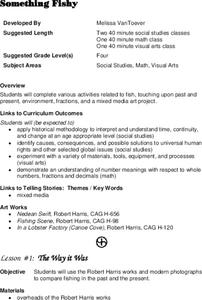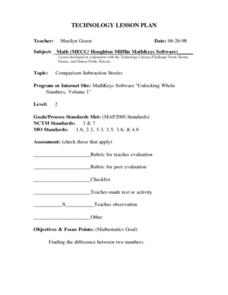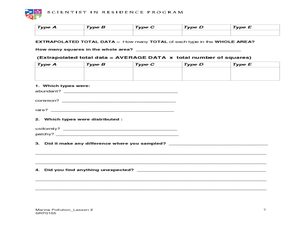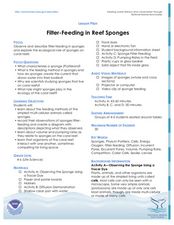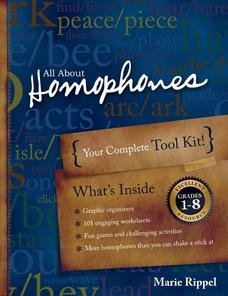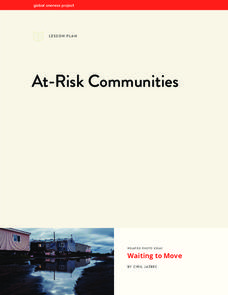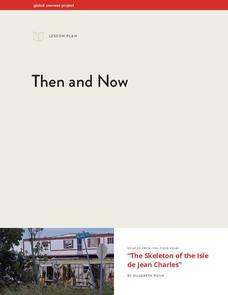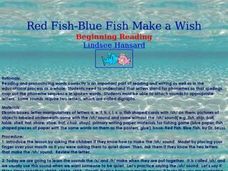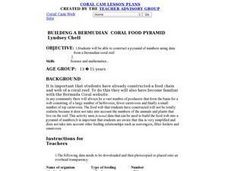Curated OER
Something Fishy
Fourth graders study the Robert Harris works and modern photographs. They compare fishing in the past and the present. They use their knowledge of equivalent fractions to play a version of the game "Go Fish".
Curated OER
Comparison Subtraction Stories
Second graders create stories that model comparison subtraction while using the environmental mats. They suggest situations in which they compare numbers. For example, if one student has 6 nickels and another child has 14 nickels,...
Curated OER
Scientific Sampling
Students take a sample of fish and try to determine how many fish are in the sea. In this scientific sampling lesson, students explore the way scientists measure large areas of samples. Students record the distribution in a quadrant.
Curated OER
Addition with Regrouping
In this regrouping in addition worksheet, students use the table for the 'Threatened and Endangered Animals' and their numbers to solve the addition problems that utilize regrouping.
Curated OER
Water Wonders
Students explore hydrology concepts. In this environment and biology instructional activity, students identify and describe macroinvertebrates using a variety of pictures and resources. Students observe and write about a classroom...
Curated OER
The Looking Glass
Sixth graders investigate the intention behind artists' works and contemplate the notion that art mirrors life. They respond orally and in writing to a painting and recognize that seeing the whole picture can offer a different ...
Curated OER
Get Ready, Get Set, Hibernate
Students match each body part or idea from a work bank about methods of animal adaptations for winter survival. They observe as the first one, food is covered with the whole class before completing the rest of the diagram. They discuss...
Curated OER
Ocean Currents and Sea Surface Temperature
Students use satellite data to explore sea surface temperature. They explore the relationship between the rotation of the Earth, the path of ocean current and air pressure centers. After studying maps of sea surface temperature and ocean...
Curated OER
Filter Feeding in Reef Sponges
Students investigate the role of sponges in our oceans. In this biology lesson, students create a diagram visualizing how sponges bring food into their bodies through a filtering process. Students discuss the connections between...
Curated OER
Compare Sets of Objects Guided Lesson
Practice math vocabulary terms fewer, more, and data using this visual-object-analysis guide. Learners observe three sets of objects and answer three questions, two of which compare numbers of objects, and the last which asks scholars to...
Curated OER
Lesson Exchange: Is This A Real Word? (Elementary, Reading/Writing)
Young readers practice looking words up in the dictionary. This lesson plan describes a simple, yet engaging, game that can be played as a whole-class activity.
Curated OER
Picnic Fun
In this addition equations worksheet, students read each word problem and use the numbers to write an addition equation. Students then solve the equations.
Curated OER
How Much Is A Million
Help young learners visualize the concept of "a million." To convey concepts of numeration and literacy, they will listen to the book How Much is a Million? by David Schwartz. They should be able to make self-to-text connections....
Road to Grammar
100 Ice-Breaker Questions
What if you could ease your English language learners into class with engaging questions? You can do just that with these questions. The questions, designed to prepare learners for working with English, are grouped by topics, such as...
Weebly
Ancient China
From China's physical geography and earliest beginnings of civilization to the Qin and Han dynasties, here is a nicely designed worksheet on ancient China, which includes a graphic organizer and timeline to summarize the reading material.
Curated OER
All About Homophones
Put the fun back in reading fundamentals with an interactive set of lessons about homophones. Learners of all ages explore the relationships between words that sound the same but have different meanings, and complete a variety of fun and...
Global Oneness Project
At-Risk Communities
"Waiting to Move," a photo essay by Ciril Jazbec, brings into sharp focus the threats posed by climate change. Class members examine images of Shishmaref Island and the Native Alaskan Inupiate coastal villages that are impacted by rising...
Global Oneness Project
Then and Now
The devastating changes happening to the Native American inhabitants of an island off the coast of Louisiana are the topic of an informational lesson. After scholars break into groups to explore particular topics, they come back together...
Curated OER
Five
Students practice printing the numeral and the word for the number 5. Students also practice spelling the word and counting the number of fish on the learning exercise.
Curated OER
Who Can Harvest A Walleye?
Seventh graders investigate the concept of how an ecosystem is put together while conducting research using a variety of resources. They correctly differentiate between a herbivore and carnivore by placing them in the order of hierarchy...
Curated OER
Red Fish-Blue Fish Make a Wish
Students to read and pronounce words correctly. They investigate the letters that stand for phonemes so that spellings map out the phoneme sequence in spoken words. Students attach sounds to appropriate letters. They have some sounds...
Curated OER
Multiplication Stories
Second graders solve various multiplication math word problems involving cars and people, fish and fish bowls, and tables and table legs. They write and solve multiplication story problems related to whole numbers, addition, subtraction,...
Curated OER
Science: Coral Reef Food Pyramid
Learners construct numbers pyramids using fictional data from a coral reef. they tally the numbers of carnivores, herbivores, and producers. Students next build a pyramid shape in which they put their numbers of producers, herbivores,...
Curated OER
Decimal Word Problems (mixed operations)
In this decimals worksheet, students solve word problems involving numbers with decimals and mixed operations. Students complete 6 problems total.


